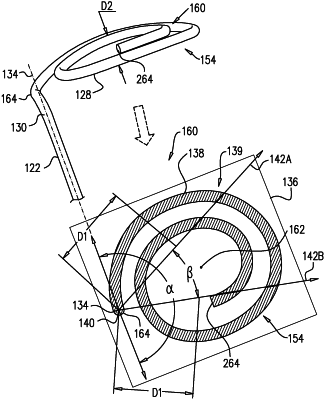| CPC A61B 17/0401 (2013.01) [A61B 17/00234 (2013.01); A61B 17/0057 (2013.01); A61B 17/068 (2013.01); A61B 17/10 (2013.01); A61F 2/2418 (2013.01); A61F 2/2427 (2013.01); A61F 2/2442 (2013.01); A61F 2/2478 (2013.01); A61F 2/82 (2013.01); A61F 2/915 (2013.01); A61B 2017/00243 (2013.01); A61B 2017/00309 (2013.01); A61B 2017/00477 (2013.01); A61B 2017/00575 (2013.01); A61B 2017/00592 (2013.01); A61B 2017/00615 (2013.01); A61B 2017/00632 (2013.01); A61B 2017/0409 (2013.01); A61B 2017/0417 (2013.01); A61B 2017/0419 (2013.01); A61B 2017/0443 (2013.01); A61B 2017/0464 (2013.01); A61B 2017/0496 (2013.01); A61B 2017/0645 (2013.01); A61B 2017/0649 (2013.01); A61F 2220/0008 (2013.01); A61F 2220/0075 (2013.01); A61F 2230/0091 (2013.01)] | 20 Claims |

|
1. A tissue anchor system for use with a deployment tool, the tissue anchor system comprising:
(i) a first tissue anchor, which is configured to be delivered to a cardiac chamber in a constrained state within the deployment tool, and which comprises:
a shaft;
a head connected to a proximal portion of the shaft; and
a tissue-coupling element, which (a) extends from a distal end of the shaft, and (b) is configured to be advanced through a heart wall;
(ii) a second tissue anchor, which is separate and distinct from the first tissue anchor; and
(iii) one or more tethers, which are configured to couple the first tissue anchor to the second tissue anchor,
wherein, when the first tissue anchor is unconstrained by the deployment tool:
the shaft has a central longitudinal axis,
the head is coaxial with the central longitudinal axis, and
the tissue-coupling element is generally orthogonal to the central longitudinal axis of the shaft and is shaped such that if the tissue-coupling element were to be projected onto a plane that is perpendicular to the central longitudinal axis, (a) at least 80% of an area of a projection of the tissue-coupling element on the plane would fall within a first angle of 180 degrees in the plane having a vertex at the central longitudinal axis, and (b) the area would partially overlap, at least 3 mm from the vertex, both rays of a second angle of between 45 and 180 degrees in the plane having the vertex at the central longitudinal axis, wherein both the rays fall within the first angle.
|